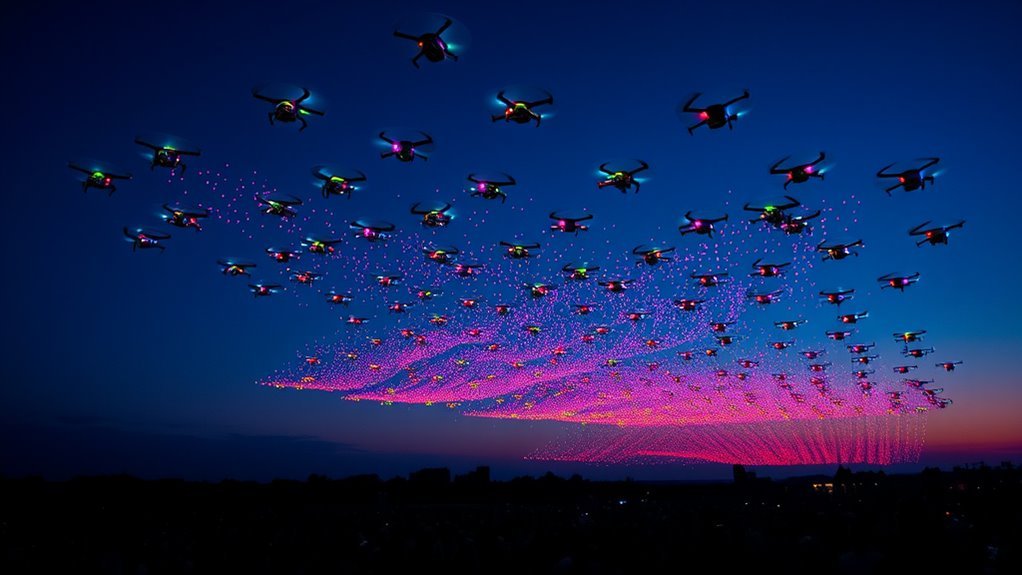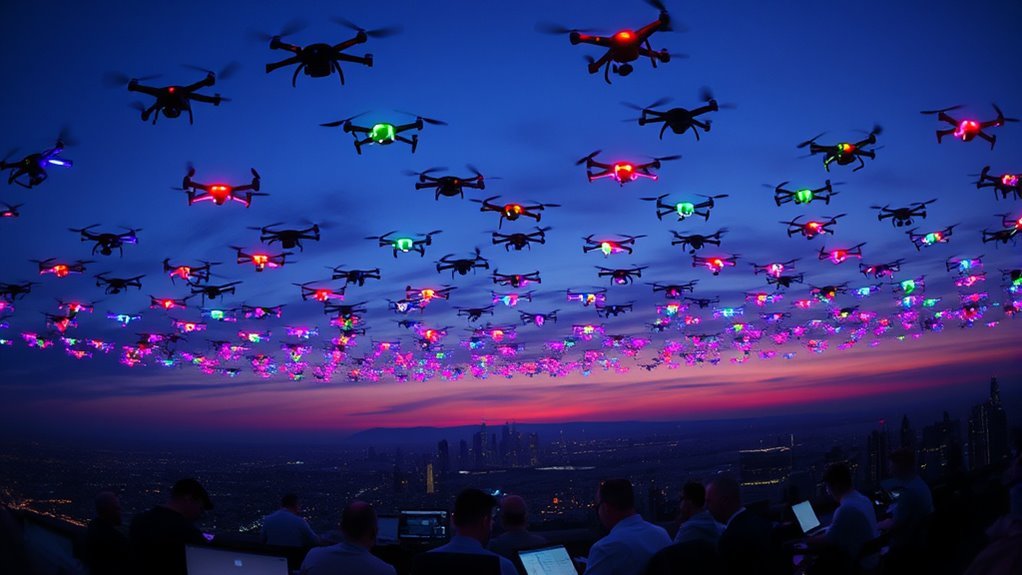To create drone shows, you start by selecting a clear theme and developing a visual concept aligned with your goals. Next, you design precise drone choreography, factoring in flight paths, timing, and collision avoidance. You program individual drones for synchronized movements with music and lighting effects. Rigorous testing guarantees hardware reliability and safety compliance. Final rehearsals refine timing, drone positioning, and signal stability. If you explore further, you’ll discover detailed strategies optimizing both creativity and performance safety.
Concept Development and Theme Selection

Before you begin designing a drone show, you need to define a clear concept and select a theme that aligns with your objectives. This initial phase demands rigorous creative brainstorming, where you critically analyze potential theme inspiration sources—cultural symbols, technological motifs, or abstract ideas—that resonate with your message. You’ll synthesize this information to formulate a coherent narrative framework, ensuring the theme provides both artistic freedom and technical feasibility. It’s essential to balance innovative expression with practical constraints like flight dynamics and synchronization capabilities. By establishing a precise concept and theme upfront, you set a strategic foundation that guides all subsequent design decisions. This analytical approach empowers you to deliver a drone show that’s not only visually compelling but also conceptually unified, maximizing impact while preserving creative autonomy.
Designing the Visual Elements

You’ll start by conceptualizing themes that align with the show’s narrative and audience expectations. Next, you’ll craft precise animation sequences to guarantee smooth drone movements and visual coherence. Finally, you’ll plan color schemes and lighting effects to optimize visibility and enhance the overall impact.
Conceptualizing Themes
Although conceptualizing themes requires creativity, it also demands a systematic approach to designing visual elements that effectively communicate the intended message. You’ll start with theme brainstorming, identifying core ideas that resonate with your audience’s desire for freedom. Visual storytelling then translates these ideas into coherent, dynamic imagery. To stay precise, analyze how each visual element supports your narrative.
| Theme Idea | Visual Elements | Message Conveyed |
|---|---|---|
| Liberation | Breaking chains, open skies | Overcoming constraints |
| Exploration | Stars, drones in flight | Pursuit of knowledge |
| Unity | Interlocking patterns | Strength in collaboration |
Crafting Animation Sequences
When crafting animation sequences, you must translate static visual concepts into fluid, dynamic movements that maintain clarity and impact. Start by selecting appropriate animation techniques that optimize drone agility and spatial constraints. You’ll analyze the interplay of each drone’s trajectory, guaranteeing smooth shifts while avoiding collisions. Precise sequence timing is critical; it synchronizes motion with the show’s rhythm and enhances visual coherence. You’ll break down complex animations into incremental steps, allowing for iterative refinement and error correction. Pay close attention to acceleration patterns and pauses, as these affect audience perception of motion fluidity. By balancing technical parameters with creative freedom, you guarantee the animation sequence is both visually striking and operationally feasible, pushing the boundaries of drone performance without sacrificing safety or clarity.
Color and Light Planning
Since color and light define the visual identity of a drone show, meticulous planning is essential to achieve both vibrancy and legibility. You’ll apply color theory principles to select hues that maximize contrast and harmony, ensuring each drone’s light complements the overall palette. Balancing saturation and brightness is critical, as overly intense colors can cause visual fatigue, while weak light diminishes impact. Adjusting light intensity per drone allows you to create depth and highlight key elements dynamically. You must also consider environmental factors—ambient light, weather conditions—that affect perceived colors and brightness. By integrating precise calculations of color temperature and luminous flux, you guarantee that the visual elements remain crisp and engaging, granting your audience the freedom to experience a compelling and immersive aerial narrative.
Creating the Flight Path and Choreography

Before you can bring your drone show to life, you need to meticulously design the flight paths and choreography for each drone, ensuring precise timing and spatial coordination. This process centers on flight trajectory optimization and aerial choreography design to maximize freedom in movement while maintaining safety.
Designing drone flight paths and choreography ensures precise timing, spatial coordination, and safe, dynamic movement.
Key steps include:
- Mapping individual drone trajectories to avoid collisions
- Synchronizing movements with music and light cues
- Utilizing software simulations to refine choreography
- Allocating spatial zones for each drone’s path
- Adjusting flight patterns for environmental variables
Drone Fleet Preparation and Testing
Before launching your drone show, you’ll need to perform thorough maintenance checks to guarantee all hardware components function at their best. Next, calibrate your software systems precisely to align with the planned choreography and flight parameters. Finally, run extensive flight path simulations to validate coordination and identify potential issues before live execution.
Drone Maintenance Checks
Although drone shows rely heavily on advanced choreography and programming, the foundation of a successful performance rests on rigorous maintenance checks. You need to conduct thorough drone inspections and equipment maintenance to guarantee reliability and safety. Skipping these steps risks malfunctions mid-show, limiting your creative freedom.
Here are essential maintenance checks you should perform:
- Inspect propellers for cracks or wear
- Verify battery health and charge cycles
- Test motor responsiveness and smooth operation
- Check sensor calibration and connectivity
- Examine structural integrity of the drone frame
Software Calibration Processes
Since precise coordination is essential for drone shows, software calibration processes play an important role in preparing and testing your drone fleet. You’ll rely on advanced calibration techniques to align sensors, optimize communication protocols, and synchronize control software across all units. Rigorous software testing guarantees that each drone responds accurately to commands, maintaining formation integrity and timing precision. Calibration addresses discrepancies in hardware variances, environmental influences, and signal latency, enhancing overall reliability. By systematically adjusting parameters through automated scripts and manual interventions, you eliminate inconsistencies that could disrupt the choreography. This meticulous calibration phase empowers you with the freedom to execute complex aerial displays confidently, knowing your fleet operates as a cohesive, finely tuned system ready for flawless performance.
Flight Path Simulations
Three critical components define effective flight path simulations for drone fleet preparation and testing: trajectory accuracy, collision avoidance, and timing synchronization. When you run simulations, you rely on advanced simulation software that models precise flight dynamics, ensuring each drone follows its intended path without deviation. This process lets you identify and correct potential conflicts before actual deployment, granting operational freedom and safety.
Key factors you’ll focus on include:
- Real-time trajectory tracking
- Predictive collision detection
- Synchronization of drone maneuvers
- Environmental condition modeling
- Optimization of battery usage during flights
Programming Individual Drone Movements
Programming individual drone movements requires meticulous attention to timing, spatial coordinates, and velocity parameters to guarantee synchronized execution within the show. You’ll deploy advanced movement algorithms that calculate each drone’s trajectory precisely, ensuring collision-free paths and fluid shifts. By inputting exact coordinates and speed vectors, you define how drones navigate 3D space independently yet cohesively. Drone coordination hinges on these algorithms’ ability to adjust for environmental variables and maintain formation integrity. You must also factor in acceleration and deceleration rates to keep movements smooth and responsive. This granular control lets you unleash dynamic, complex patterns that express creativity without compromising safety or reliability. Ultimately, programming these individual motions is about balancing technical rigor with the freedom to craft visually stunning aerial performances.
Synchronizing Drones With Music and Effects
After defining each drone’s individual movements with exacting detail, the next step is aligning those motions seamlessly with musical rhythms and visual effects. Achieving precise music synchronization requires you to analyze audio waveforms and tempo, ensuring drones’ choreography matches beat and mood. Effects integration demands real-time control over lighting, smoke, or pyrotechnics to complement drone positions and shifts. To master this, you’ll focus on:
Seamlessly synchronize drone movements with music and effects for immersive, dynamic performances perfectly in sync.
- Mapping key musical cues to drone formation changes
- Calibrating timing delays between audio playback and drone response
- Programming lighting sequences tied to specific beats
- Synchronizing auxiliary effects with drone altitude and speed
- Testing combined systems for latency and coherence
This technical orchestration grants you freedom to craft immersive, dynamic performances where every element is perfectly in sync.
Safety Protocols and Regulatory Compliance
While crafting an enchanting drone show demands technical finesse, guaranteeing safety and regulatory compliance is equally critical to protect participants and audiences. You must rigorously adhere to regulatory guidelines set by aviation authorities, which govern flight altitude, no-fly zones, and drone weight classifications. Implementing robust safety measures, such as real-time geofencing and fail-safe protocols, minimizes risks of collisions or uncontrolled descents. Pre-flight risk assessments are essential to identify hazards and establish emergency response plans. You should also secure necessary permits and coordinate with local agencies to align your show with legal requirements. Balancing creative freedom with strict compliance guarantees the spectacle unfolds without jeopardizing safety or violating regulations. Ultimately, your commitment to these protocols safeguards both your audience’s well-being and your operation’s legitimacy.
Rehearsals and Final Adjustments
Before the live performance, you’ll conduct multiple rehearsals to validate the drone choreography, timing, and synchronization under operational conditions. This phase guarantees that each drone responds precisely within the designated airspace and choreography sequence. Focusing on rehearsal timing helps you identify and correct any lag or misalignment in drone movements. Final adjustments are critical to optimize battery usage, refine signal stability, and perfect visual effects. Your goal is to secure flawless execution while maintaining creative freedom.
Key rehearsal and adjustment steps include:
- Verifying drone positioning accuracy in 3D space
- Testing communication link robustness
- Calibrating light intensity and color fidelity
- Adjusting choreography for environmental factors
- Synchronizing drones with music and narration cues
This rigorous process safeguards both safety and artistic expression.

